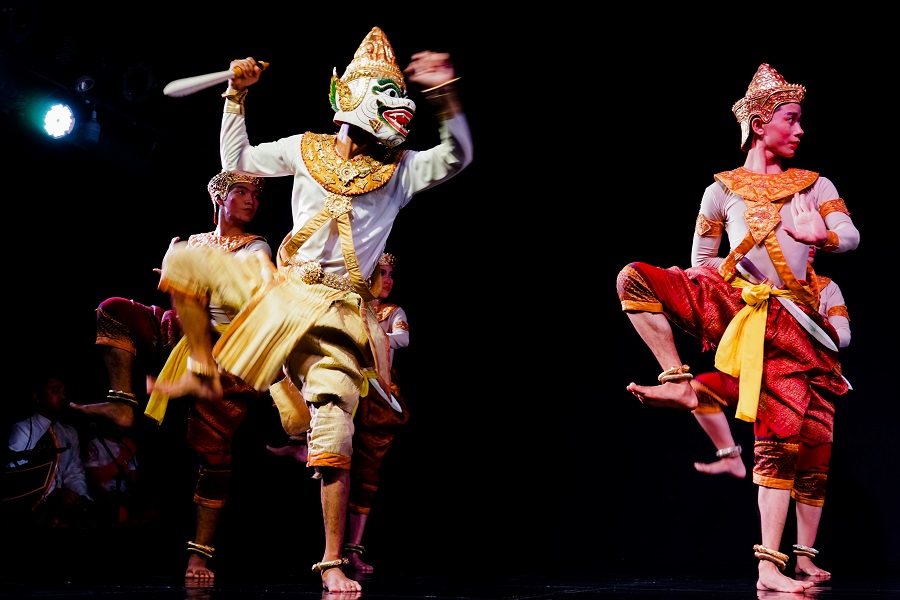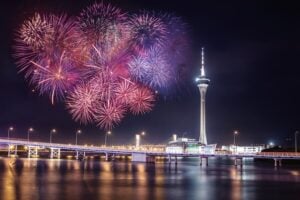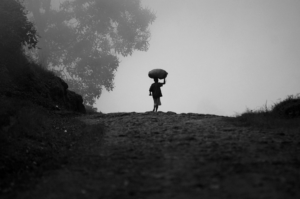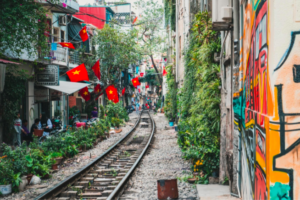Personal essays on the Golden Land
As told by James Pham, Rachael Mussig, Shauna O Mahony, and Leanna Payne
Living in Cambodia is at times incredibly infuriating yet touchingly endearing. Streets are alternately dusty or muddy, depending on the season, but reliably congested with tuktuks, cars, and motorbikes, especially in Phnom Penh, where even short distances take unreasonably long to cover. The heat gets oppressive, even by 8 in the morning, soaking through your clothes. Despite all this, there’s something about Cambodia that works its way under your skin and becomes a part of you. It’s the corner moto dup (motorcycle taxi) guy who knocks on your door to make sure you’re okay after you’ve been MIA for a few days with dengue. It’s a complete stranger who after a few minutes of chitchat decides to open up about their experience during the Khmer Rouge, silent tears punctuating their story. It’s sharing a bag of boiled peanuts with some friendly students along the riverside as pigeons circle overhead and the odd elephant lumbers down the street. Also known as Kampuchea, derived from a Sanskrit word meaning “Golden Land”, Cambodia entrances, infuriates, and inspires, etching memories both tarnished and glittering. These are the stories of three women who have made Cambodia their own.
The Dreamer, as told by Rachael Mussig
It never ceases to amaze me just how much was going on in this country while the outside world just moved on. Cambodia in the 1970s was in the grip of terror under the rule of the Khmer Rouge, and the after-effects of this rule are still impacting Cambodia today. What never surprises me, however, is the Cambodian people, the people who showed resilience and strength to overcome atrocities like they had never known. Cambodian people like the founder of Cambodian Living Arts (CLA), Arn Chorn Pond.

CLA Performance
Arn was born into a family of artists, but in 1975 was sent to a child labor camp under the rule of the Khmer Rouge. In order to survive, he learned from a Master Artist how to play khim, a hammered dulcimer, to entertain the soldiers. Eventually, he escaped to a refugee camp in Thailand and was adopted by an American family and grew up in the US. Later, he returned to his much-loved Cambodia to rebuild the legacy of his family. Over 90 percent of Master Artists lost their lives to the Khmer Rouge and in 1998, Arn, with the support of a small group of dedicated people, created a program to bring back the Cambodian arts, and CLA was born.
Why am I so passionate about this organization? I am lucky enough to be in Cambodia with the Australian Volunteers Program, and from the moment I read about the position, it grabbed me by the heartstrings. Having travelled to Cambodia before and falling in love with the country, my life and career path were destined to come back again someday… and that day has come.
There are so many reasons why I love CLA, and more specifically the cultural enterprise of CLA that I work for, Experience Cambodian Living Arts (ECLA). Experience Cambodian Living Arts lives out its mission each day, to share amazing arts and culture to audiences around the world and to create a sustainable future for the artists that we support. This is done through providing employment opportunities for 30 artists in the incubator program, who perform on stage each night in the dance show, “Earth and Sky”. The dream is that with professional training and personal growth, these artists will be able to continue to work in the arts for years to come. The artists also coordinate a daily dance workshop and do private performances and workshops.

CLA Workshop
The artists bring Cambodian arts to life in their performances every day and the passion and enthusiasm they have for what they do is truly inspiring. There is no single artist on the stage; they are all in this together and that is really clear backstage before a performance. Many of the costumes require the artist to be sewn into them, crowns need to be placed, hair and make-up needs to be perfect and everyone works together to make this all happen. There is an energy that the artists exude, and it is infectious. All this happens before they even take to the stage.
Each artist truly feels privileged to be a part of the incubator program, and under the direction of Voan Sovay, herself a ballerina in the Royal Ballet of Cambodia before the Khmer Rouge, they know that they are being trained by the best. One of my Cambodian highlights so far was taking part in the Sampeah Kru earlier this year, a praying ceremony where the artists give thanks to their teachers, past and present, and remember the souls of those who have taught them dance and morality. To see such a reverent ceremony and the artists so respectful to their teachers really reiterated the importance of preserving Cambodian arts.
Coming to work every day is a joy. Being a part of an organization that is truly achieving amazing things in the arts sector is a joy. Arn has said that his dream is that one day, every child in Cambodia would carry a musical instrument and not a weapon as he did. After 20 years of Cambodian Living Arts, this dream is becoming a reality.
The Artist, as told by Shauna O Mahony
Cruising around the streets of Phnom Penh in a classic remorque, one can easily see Cambodia as a land of smiles. It is just after sunrise and locals in the capital are busying themselves selling coffee, fruit and delicious breakfast dishes, often to a backdrop of stunning street art created by local and international artists.
Up until the 1960s, Phnom Penh was known as the “Pearl of Asia”, in part because of the groundbreaking art, music, and film being produced by the Kingdom. The following decade, Cambodia lost this reputation due to the tragic and brutal Khmer Rouge regime which oversaw the death of 90 percent of Cambodia’s artists.

The Factory
Forty years later, one thing is clear—you can’t kill creativity and Phnom Penh is at the epicentre of a cultural renaissance sweeping the nation to reinstate the city to its former glory. After spending five years in Phnom Penh, I’ve had the privilege of facilitating the booming street art scene by connecting artists with local usinesses and projects. This has multiplied the number of murals littered around the city (now close to 100) and most importantly, has fostered an appreciation for urban arts within the local community. We’ve hosted amazing international urban artists including Seth Globetrotter (France), Alex Face (Thailand), and Mate2 (UK). This era can be considered the Cambodian Art Renaissance, with the past five years seeing more artists, exhibitions, workshops, and festivals than the preceding 40 years.

Boeung-Kak
Independent art galleries are at the forefront of Phnom Penh’s art renaissance. For example, since its conception in 2017, the KBach Gallery has worked tirelessly to identify, support, and promote Khmer-inspired artists. Most notable among these are the winners of the KBach Arts Competition 2018: Hour Soben and Nguon
Kolkateka. These young Cambodian artists effortlessly fuse traditional Cambodian elements with international urban art to create a unique “Kbach” style. Soben paints stone-like faces inspired by sculptures of Jayavarman VII in Angkor Wat juxtaposed with psychedelic backgrounds and riddled with Khmer motifs. Kolkateka, on the other hand, paints seemingly traditional scenes from Cambodian mythology which upon closer inspection include homages to contemporary international pop culture.
Pearls take seven years to form and mature and the same can be said for Phnom Penh. It will take a few more years for the cultural arts market to mature to its full potential. However, in the meantime, Phnom Penh has enough hidden gems to satiate any art lover.
The Foodie, as told by Leanna Payne
Both working in relief aid, my parents met in Cambodia during the time the Khmer Rouge were trying to retake the country from the newly formed national government. Growing up in Phnom Penh, I’ve seen this modest 8 square kilometer patch of land transform from where Pol Pot was the nightmarish bogeyman out in the countryside to an international city replete with modern luxuries. You don’t witness something like that without an appreciation of the human ability to continuously choose optimism.
My parents often traveled to conflict regions for work, so I was also raised by three Cambodian women in a kitchen. It was from them that I learned that food was how a culture negotiated its relationship with its environment and its people.

Local Noodles
As survivors who lost their rural childhood to the American carpet bombings of the countryside and subsequent Khmer Rouge genocide, food connected my Aunties to their ancestry. Under the Khmer Rouge, rice was seen as the Nationhood which in turn complicated their relationship with food. It wasn’t simply sustenance, history, and culture to them, but all those things taken to impossible extremes. Dance with me in that thought for a while.
Much later, as they began raising children of their own under more peaceful conditions that they were able to redefine that relationship to one of love and pass down that intangible heritage. Growing up, we had limited electricity and lived out of those classic giant orange iceboxes that still are a quintessential part of Cambodia’s scenery. Every morning at about sunrise, I’d get taken to the market on a rickety Honda Super Cub and receive a careful education on what to look for in freshness and seasonality. Once home, we learned how to balance flavors, textures, and concepts on a single plate.

Leanna on tour – Image by Lost Plate
I was fortunate to have been raised by people who put their soul into their food. But for many Cambodians, the definition of authentic Khmer cuisine is not so clear. In a country where the majority of people over 40 have experienced considerable trauma, many have not been able to redefine their relationship with food. Understandably so, given genocide, the disconnect during the famine that followed, and the general unavailability of a variety of produce for many years. Kids at school began bringing fast food for lunch when that entered Cambodia’s marketplace, and I saw Cambodians mistake Vietnamese cuisine such as banh xeo as their own because they couldn’t differentiate street food from Khmer.

The Pickle Man – Image by Lost Plate
When I ask Khmer people what their favorite food is, many will say it’s amok, a uniquely Khmer steamed curry, but when pressed, won’t be able to recall the last time they ate it. It’s what they feel is the expected answer, and the obvious one because it’s on every tourist menu. For a very long time, there’s been a lack of self-awareness or thought into what Khmer food is, and if so, only from the perspective of Westerners.
When I started connecting with chefs I realized that there were quite a few of us that grew up with Aunties who dutifully pointed out details in markets and scolded us in kitchens, people who also grew up frustrated and curious about a lack of care in local restaurants, about supermarkets and the internet, about fast food lunches.
“Outside” food during my childhood were strictly limited to the realms of fried noodles and grilled pork over rice, just the surface of what Khmer food really is. Today, though, I see exciting new yet old “discoveries” on my Facebook feed, daily market excursions, or in passing restaurants during my Honda Super Cub rides. If food were a love language, then Cambodia is finding its voice. Having recovered from famine and war, markets are now bursting with ingredients chefs haven’t touched in decades.

Boeung Keng Kang Market
When the French first arrived, they identified 2,000 varieties of rice unique to this tiny country. Our largest lake, the Tonle Sap, is the largest reservoir of freshwater fish in the world, boasting a volume five times more than all of North America combined. This wealth is finally coming into play.
Cambodia’s reemerging food scene also benefits from not being industrialized. While neighboring Thailand only has three farms where palm sugar is still made traditionally, here my BBQ man will berate how rains have affected the complexity of the sugar palm in the south this week. Even salts are still traditionally made by hand, allowing for an indescribable layering of flavors and sensations. My whole life I’ve been witnessing this culinary renaissance continue to ebb and swell with no end in sight, and I have never been hungrier.

BBQ Master – Image by Lost Plate
IF YOU GO
Experience Cambodian Living Arts puts on the highly entertaining “Earth and Sky” dance show every evening in a theater on the quiet grounds of the National Museum of Cambodia. The one-hour show features dozens of performers in full costumes, accompanied by live traditional music, showcasing elements of Cambodian mythology, ancient traditions, and village life. For an even more intimate experience, take the 90-minute afternoon workshop where a handful of dancers teach you the fascinating meanings behind the hand gestures as well as a series of dances. For more info, including private performances, workshops or family and school trips, visit www.experience.cambodianlivingarts.org
Shauna O Mahony is the owner/director of KBach Gallery (www.kbachgallery.com) as well as managing director of Urban Forage. Founded by food fanatic, Australian Sonya Duck, Urban Forage specializes in street food and street art tours as well fine dining and fine art tours, in partnership with KBach Gallery. Known for its relaxed, casual yet professional approach to tours, Urban Forage understands that most people want to feel submerged in the adventure, rather than on a scripted tour. In addition to Phnom Penh, Urban Forage has now launched in
Siem Reap, offering the region’s first “Rolling Food Tour” and Bar Cycle. For more, visit www.urbanforage.co and www.barcycle-cambodia.com
Leanna Payne is the resident food nerd and Operations Manager for Lost Plate Food Tours, and is currently on her 23rd year of residency in Phnom Penh a few blocks from her favorite market. When she isn’t there, she’s in Siem Reap meeting chefs and fishermen for their upcoming Siem Reap Food Tour. Dinners with her and her team of culinary ambassadors start at USD59 per person. Find more details at www.lostplate.com
Images by James Pham






